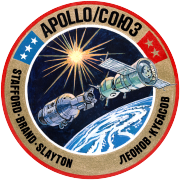Soyuz 19

The Apollo spacecraft, as seen by the Soyuz crew.
|
|
| Mission type | Cooperative/scientific |
|---|---|
| Operator | NASA |
| COSPAR ID | 1975-066A |
| SATCAT № | 8032 |
| Mission duration | 9 d 01 h 28 min |
| Distance travelled | ~5,990,000 km (3,720,000 mi) |
| Orbits completed | 148 |
| Spacecraft properties | |
| Spacecraft | Apollo CSM-111 |
| Launch mass | 16,780 kg or 36,990 lb (total CSM and DM) |
| Dry mass | 14,768 kg (32,558 lb) (CSM) |
| Payload mass | 2,012 kg or 4,436 lb (Docking Module) |
| Crew | |
| Crew size | 3 |
| Members | |
| Callsign | Apollo |
| Start of mission | |
| Launch date | 19:50:00, July 15, 1975 (UTC) |
| Rocket | Saturn IB SA-210 |
| Launch site | Kennedy LC-39B |
| End of mission | |
| Recovered by | USS New Orleans |
| Landing date | 21:18:00, July 24, 1975 (UTC) |
| Landing site | 21°52′N 162°45′W / 21.867°N 162.750°W |
| Orbital parameters | |
| Perigee | 217 km (135 mi) |
| Apogee | 231 km (144 mi) |
| Inclination | 51.7° or 51.75° |
| Period | 87.6 or 88.91 minutes |
| Docking with Soyuz 19 | |
| Docking date | First: 16:19:09, July 17, 1975 (UTC) |
| Undocking date | Last: 15:26:12, July 19, 1975 (UTC) |
| Time docked | 1 day, 23 hours, 07 min, 03 sec |
 Left to right: Slayton, Brand, Stafford |
|

Soyuz 19 as seen from the Apollo.
|
|||||
| Mission type | Cooperative/scientific | ||||
|---|---|---|---|---|---|
| COSPAR ID | 1975-065A | ||||
| SATCAT № | 8030 | ||||
| Mission duration | 5 d 22 h 30 m | ||||
| Distance travelled | ~3,900,000 km (2,400,000 mi) | ||||
| Orbits completed | 96 | ||||
| Spacecraft properties | |||||
| Spacecraft type | Soyuz 7K-TM | ||||
| Dry mass | 6,790 kg (14,970 lb) | ||||
| Crew | |||||
| Crew size | 2 | ||||
| Members | |||||
| Callsign | Союз (Soyuz - "Union") | ||||
| Start of mission | |||||
| Launch date | 12:20:00, July 15, 1975 (UTC) | ||||
| Rocket | Soyuz-U | ||||
| Launch site | Gagarin's Start, Baikonur Cosmodrome | ||||
| End of mission | |||||
| Recovered by | Soviet Armed Forces | ||||
| Landing date | 10:50:00, July 21, 1975 (UTC) | ||||
| Landing site | 50°40′N 67°1′E / 50.667°N 67.017°E | ||||
| Orbital parameters | |||||
| Perigee | 218 km (135 mi) or 186 km (116 mi) | ||||
| Apogee | 231 km (144 mi) or 220 km (140 mi) | ||||
| Inclination | 51.76° or 51.8° | ||||
| Period | 88.92 or 88.5 min | ||||
| Docking with Apollo CSM-111 | |||||
| Docking date | First: 16:19:09, July 17, 1975 (UTC) | ||||
| Undocking date | Last: 15:26:12, July 19, 1975 (UTC) | ||||
| Time docked | 1 day, 23 hours, 07 min, 03 sec | ||||
|
|
|||||
The Apollo–Soyuz Test Project (ASTP) (Russian: Экспериментальный полёт «Союз» — «Аполлон», Eksperimantalniy polyot Soyuz-Apollon, lit. "Experimental flight Soyuz-Apollo"), conducted in July 1975, was the first joint U.S.–Soviet space flight, as a symbol of the policy of détente that the two superpowers were pursuing at the time. It involved the docking of an Apollo Command/Service Module with the Soviet Soyuz 19. The unnumbered Apollo vehicle was a surplus from the terminated Apollo program and the last one to fly. This mission ceremoniously marked the end of the Space Race that had begun in 1957 with the Sputnik launch.
The mission included both joint and separate scientific experiments (including an engineered eclipse of the Sun by Apollo to allow Soyuz to take photographs of the solar corona), and provided useful engineering experience for future joint US–Russian space flights, such as the Shuttle–Mir Program and the International Space Station.
ASTP was the last manned US space mission until the first Space Shuttle flight in April 1981. It was also U.S. astronaut Donald "Deke" Slayton's only space flight. He was chosen as one of the original Mercury Seven astronauts in April 1959, but had been grounded until 1972 for medical reasons.
...
Wikipedia



